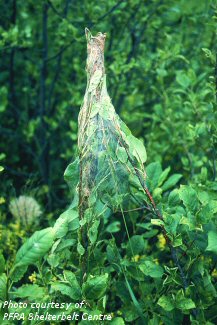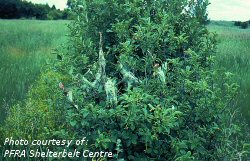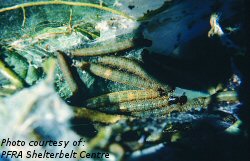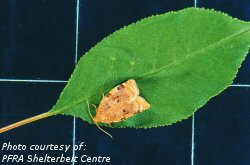Ugly Nest Caterpillar (Archips Cerasivorana)

Ugly nest caterpillar damage

Ugly nest caterpillar damage

Ugly nest caterpillar larvae

Ugly nest caterpillar adult
Host Plants And Distribution
Chokecherry is the main host for this insect. It will also feed on pin cherry, black cherry and other hardwood trees and shrubs. This insect is found across Canada and the northern United States.
Biology
The ugly nest caterpillar has one generation per year. Eggs are laid in the fall and the insect overwinters in this stage. The eggs hatch at the same time as chokecherry leaves flush. Larvae feed from May to September in an enclosed nest of foliage and silk. When they are fully grown (22 mm), the larvae pupate in the nest. Adults are dull yellowish-orange, with a wingspan of about 22 mm. Adults are active from late June to September, when egg laying occurs on the bark of host plants.
Symptoms And Damage
Larvae construct silken tents at the top of individual plants. Foliage is webbed together to form a nest that the larvae feed, defecate and pupate in. Nests may cause some branch deformity in years following infestation, but otherwise cause little permanent damage. Nests are very unsightly in orchard and ornamental plantings.
Scouting Techniques
Nests are very obvious and easily located by visual inspection. Checking the orchard weekly for developing nests should allow for early detection.
Economic Thresholds
No economic thresholds have been established for this insect. It is difficult to tell the nests of the ugly nest caterpillar from those of the fall webworm. Treatment of both nests is the same. Infestations can be controlled by pruning and destroying nests.

